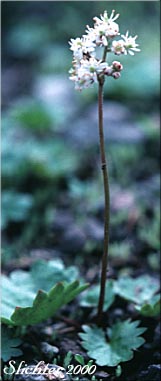 Photo
at right of Saxifraga punctata from the Timberline Trail west of Cloud
Cap, Mt. Hood Wilderness.......August 1989.
Photo
at right of Saxifraga punctata from the Timberline Trail west of Cloud
Cap, Mt. Hood Wilderness.......August 1989.
Dotted saxifrage may be confused with brook saxifrage (Saxifraga arguta).
Dotted saxifrage is a perennial with a single stem (usually) from 10-30 cm in height. The stem is unbranched and leafless. Any glands that are present are not purplish. There are several basal leaves which often have petioles ranging from equal in length to five times the length of the blades. The blades are kidney-shaped and 2-6 cm wide. The length of the blades are 1/2- 4/5 the width. The surface of the blades is generally smooth. The margins are coarsely 7-21 toothed. These teeth are up to 1 cm long and ovate in shape.
The inflorescence is a compact, rounded cymose-panicle with many white flowers. The inflorescence elongates to about 15 cm in fruit. The calyx is cleft nearly to the base, with the reddish lobes reflexed, to 1.5 mm in length and oblong-ovate to lance-oblong in shape. The petals are white and 2.5-3.5 mm long. They are narrowly to broadly oblong or oblong-elliptic in shaped and are more than 1.5 time longer than wide. The petals are all the same size and shape and have 2 yellow dots near the base (a difference from Saxifraga arguta.) The stamens are shorter than the petals.
Dotted saxifrage may be found in wet meadows and along streams or springs at moderate elevations.
Dotted saxifrage may be found from southern Alaska south through British Columbia to the Cascade and Olympic Mts. of Washington and Oregon. It may be found east through British Columbia to Alberta.
In the Columbia River Gorge, it may be found in the mid-gorge near 4200'.